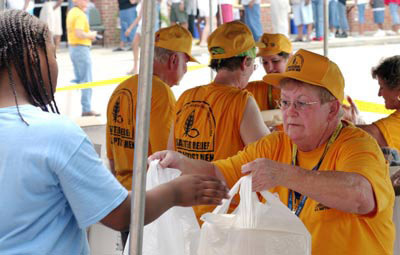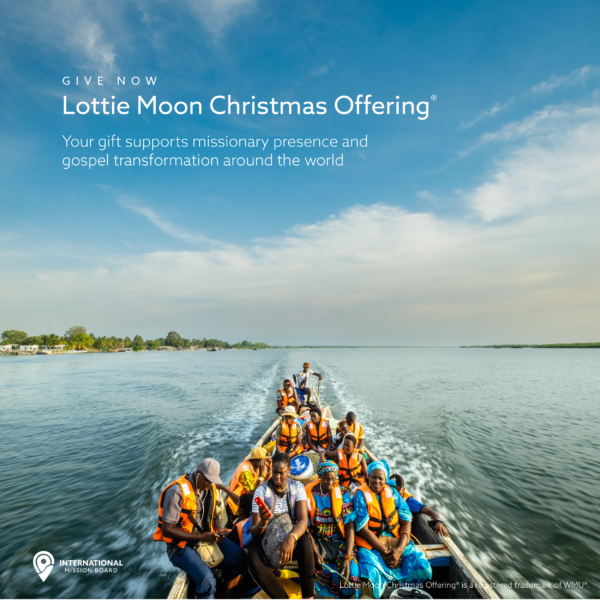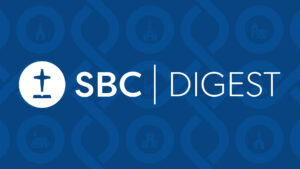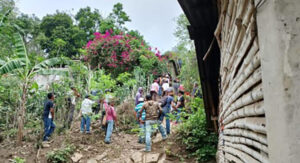
ALPHARETTA, Ga. (BP)–“As early as Aug. 26, we had pulled in a skeleton crew and opened the disaster operations center [DOC],” recounted Mickey Caison, disaster relief coordinator at the North American Mission Board in Alpharetta, Ga., in 2005. “We had also called the state conventions and mobilized an incident command team.”
On Monday, Aug. 29, at about 6:10 a.m. Hurricane Katrina made its monstrous landfall in southeast Louisiana. Packing 125 mph winds with intense central pressure, Katrina would be the third most powerful storm to ever hit the United States — and one of the deadliest.
More than 1,800 would perish directly in the hurricane itself or from the unprecedented flooding to follow. Eighty percent of New Orleans and surrounding parishes were flooded when levees broke; the putrid floodwaters — contaminated with sewage, gasoline, oil and chemicals — lingered for weeks.
With some 300,000 homes and businesses destroyed or damaged, Katrina left $81 billion in damages in its wake, the costliest hurricane in U.S. history. Mississippi beach towns like Gulfport and Biloxi — where the surge flooded inland as far as 12 miles — were devastated. One-third of New Orleans’ population moved away and never returned.
Today, Caison will tell you that just as things were never the same after Pearl Harbor, JFK’s assassination or 9/11, the Gulf Coast and Southern Baptist Disaster Relief (SBDR) have not been the same since Katrina.
Caison and the SBDR team initially thought Katrina would only be a “wind event” — albeit a serious one — with destructive wind damage predicted as far north as Jackson, Miss.
Caison and his team had local disaster relief teams hunkered down in Mississippi and Louisiana in addition to using three staging sites — Shocco Springs Baptist Conference Center near Talladega, Ala., Camp Garaywa in Clinton, Miss., and a venue in Marshall, Texas — for the scores of volunteers en route from 41 of Southern Baptists’ state conventions.
“On Tuesday, we saw the levees break and the flooding begin in New Orleans,” said Caison, now adult volunteer mobilization team leader at NAMB. “We saw the thousands of people trapped in the Superdome and the New Orleans Convention Center. We realized how bad New Orleans was going to take it.”
Starting on the western side of New Orleans and Lake Pontchartrain, and moving into southern Jefferson and Plaquemines parishes, and west of the Mississippi River down to Houma, Southern Baptist Disaster Relief finally was able to move in its first feeding and chainsaw units a few days later. “On the initial push, we had 30 feeding units deployed,” Caison said.
For 196 continuous days — from Aug. 29, 2005, until March 12, 2006 — Southern Baptist Disaster Relief was in full operation. The DOC staff in Alpharetta, Ga., initially worked around the clock and, later, 16-hour days.
While the numbers related to Katrina’s death and destruction were staggering so, too, were the numbers put up by the 21,000 Southern Baptist volunteers who came to the Gulf Coast:
— 196,310 volunteer days.
— 500 SBDR units responding from across the United States.
— 14,613,798 hot meals prepared and served to victims, volunteers and first responders.
— 21,610 gallons of water purified.
— 7,817 children cared for.
— 17,033 chainsaw and mud-out jobs completed.
— 132,019 showers provided to victims and workers.
— 27,845 laundry loads washed and dried.
— 3,107 ham radio messages delivered — vital because of wireline/wireless phone outages.
In addition to all the SBDR work under way in Louisiana and Mississippi, 13 other conventions also were responding in their own states — ministering to the 1.2 million homeless evacuees forced to leave the flooded Gulf Coast areas for places like San Antonio, Atlanta, Minneapolis and even New York.
Into the following year, Southern Baptist relief did not stop, but transitioned into Project NOAH (New Orleans Area Homes) Rebuild.
“By November and December of 2005, it was clear to us we needed a long-term rebuild program,” Caison said. Project NOAH would be funded by the balance of some $25 million Southern Baptists and others had generously contributed to NAMB and to their state convention offices for Katrina relief.
Kicking off in May 2006, Project NOAH Rebuild would draw another 26,500 volunteers from across America to New Orleans, usually staying a week at a time, sleeping on cots or in sleeping bags in New Orleans’ World Trade Center or at a Southern Baptist church in St. Bernard Parish.
These NOAH Rebuild volunteers assisted with the building or re-building of some 500 homes in New Orleans, many located in the flood-ravaged Lower Ninth Ward area where floodwater from the ruptured levees spilled over into neighborhood after neighborhood. Another 26 water-damaged churches, schools and ministry centers also were repaired under Project NOAH Rebuild.
Today, five years later — with current responses under way in Haiti, American Samoa and in recently flooded Iowa, Texas and Kentucky — Caison said the real-life lessons and inspiring examples learned from Katrina have paved the way to improvements evident in Southern Baptist Disaster Relief in 2010.
The responsiveness, capability and perseverance of state Baptist conventions showed that Baptists “really do want to serve and stepped up,” Caison said.
“And they responded not only in the early emergency phase, but also in the Project NOAH Rebuild and the rebuild in Mississippi,” he said. “We saw church-to-church partnerships spring up, and churches adopting churches that had been damaged or destroyed by the hurricane or floods.”
Caison said Hurricane Katrina also pointed out and solidified the need for more disaster relief chaplains, to the point that there are now 4,000-5,000 more trained disaster relief chaplains on standby than before Katrina.
“We’ve seen more and stronger partnerships between NAMB, the state conventions, associations and churches in disaster-affected areas because of Katrina,” Caison continued.
“The way we conducted our ministry during Katrina also caused the federal and state governments to stand up and take notice. Our relationships with FEMA and state governments changed because they finally began to understand what Southern Baptist Disaster Relief is about. Washington [D.C.] folks finally realized that we bring more to the table than our relationships with the Red Cross or The Salvation Army. They began to understand who we are and now recognize us as one of the top three disaster relief organizations in the United States.”
Caison said Southern Baptist relationships also blossomed after Hurricane Katrina with other evangelical organizations such as Samaritan’s Purse, Operation Blessing, Convoy of Hope and other para-church organizations — leading to the creation of the Christian Relief Cooperative, a group of evangelical organizations involved in disaster relief.
The number of trained Southern Baptist Disaster Relief volunteers has climbed to an all-time high of 95,000, a 46 percent increase over the 51,300 trained volunteers just prior to Katrina. In fact, just in the few months following Katrina in 2005, Caison said 25,000 new volunteers were trained.
Southern Baptist Disaster Relief’s fleet — which numbered about 800 vehicles in 2005 — has grown to 1,550 units.
The number of recovery units is now 780, including chainsaw, mud-out and repair units, not counting the 124 units used just for feeding. A number of state Baptist conventions have feeding units that can deliver more than 20,000 meals a day and did so after Hurricane Ike in Texas in 2008.
Although SBDR is sometimes spread thin — especially in the aftermath of the Haiti earthquake and the American Samoa tsunami — Caison said disaster relief workers at NAMB and out in the states are ready if a new disaster strikes. The 2010 hurricane season — predicted to be one of the most active in years — is only in its third month.
“While we have plenty of volunteers, we do have a shortage of leadership in disaster relief,” Caison said. “It’s not the quality of leadership but the quantity of leadership. Our guys out in the states wear multiple hats, and disaster relief is just one of them. We need more unit directors — ‘blue caps’ — who can operate the units day to day.
“Disaster relief continues to evolve,” Caison reflected. “The number of state conventions that have come on line have increased over the last 10 years. Some are still emerging. Usually, it boils down to funding. Most state conventions operate on the donations made during a response. If funding does not come, they cannot respond.”
Caison said Southern Baptist disaster relief’s mantra is “serving Christ in the crisis.”
“Disaster relief will continue to be used to kick down the doors of opportunity,” Caison said. “After a disaster response, there are people who come up to us and say, ‘Please start a Southern Baptist church in our community.’ We’re working harder to follow up and do just that — to use disaster relief as a means to plant new churches.”
Caison said disaster relief’s physical and spiritual ministries are two sides of the same coin.
“Jesus said to the 12: ‘Go preach, share the story and heal the sick.’ He said to the 70: ‘Go heal the sick, share the story and preach.’ We have to do both the physical and the spiritual ministries. If we don’t, we’re just a social organization.
“As people in a disaster ask us who we are, where we came from, etc., we can transition to sharing the Gospel. And while we’re harvesting during disaster relief, we’re also planting seeds and watering as well. That’s who we are. That’s our DNA.”
–30–
Mickey Noah is a writer for the North American Mission Board.













